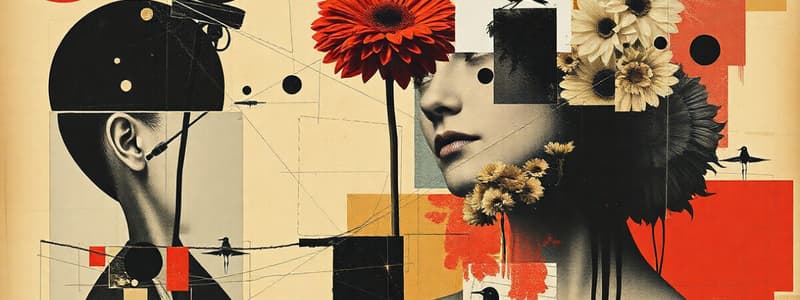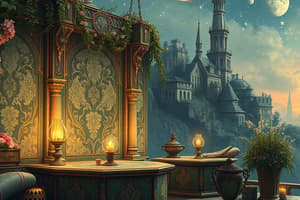Podcast
Questions and Answers
An artist wants to create the illusion of depth in a landscape painting. Which technique would most effectively simulate atmospheric perspective?
An artist wants to create the illusion of depth in a landscape painting. Which technique would most effectively simulate atmospheric perspective?
- Applying thick, textured lines to all objects regardless of their position in the composition.
- Employing geometric shapes in the foreground and organic shapes in the background.
- Using brighter, more saturated colors for objects in the foreground and duller, cooler colors for objects in the background. (correct)
- Ensuring all objects are the same size, regardless of perceived distance.
In a still life composition, how can negative space be used most effectively to enhance the positive space?
In a still life composition, how can negative space be used most effectively to enhance the positive space?
- By ignoring the empty space and focusing solely on rendering the objects with high detail.
- By minimizing the contrast between the objects and their surroundings.
- By filling the entire background with intricate patterns, leaving no empty areas.
- By strategically placing objects to create interesting and balanced empty areas around them. (correct)
An artist is creating a composition using two-point perspective. Where should the vanishing points be placed?
An artist is creating a composition using two-point perspective. Where should the vanishing points be placed?
- One vanishing point should be on the horizon line, and the other should be directly below it.
- Both vanishing points should be on the horizon line, placed far apart from each other. (correct)
- Both vanishing points should be located at the center of the picture plane.
- The vanishing points should be placed at random locations within the composition.
Which of the following strategies would best help an artist depict depth using size and placement?
Which of the following strategies would best help an artist depict depth using size and placement?
An artist aims to create a sense of harmony and balance within a landscape painting using color. Which approach would be best?
An artist aims to create a sense of harmony and balance within a landscape painting using color. Which approach would be best?
Flashcards
Line Weight
Line Weight
The thickness or thinness of a line, adding emphasis or variation to a drawing.
Secondary Colors
Secondary Colors
Colors created by mixing two primary colors (red, blue, yellow); examples include green, orange, and purple.
Positive Space
Positive Space
The area within an artwork occupied by the main subject or objects.
Neutral Colors
Neutral Colors
Signup and view all the flashcards
Overlapping
Overlapping
Signup and view all the flashcards
Study Notes
- Line: A mark made by a moving point.
- Direction: The orientation of a line, which can be horizontal, vertical, diagonal, or curved.
- Line Weight: The thickness or thinness of a line.
- Texture: The surface quality of an artwork.
- Value: The lightness or darkness of a color.
- Form: A 3-dimensional shape possessing height, width, and depth, like a sphere or cube.
- Shape: A 2-dimensional shape, such as a square or circle.
- Organic Shapes: Irregular shapes.
- Geometric Shapes: Shapes with mathematical form.
- Positive Space: The area occupied by the main subject.
- Negative Space: Empty space between subjects.
- Primary Colors: Red, blue, and yellow.
- Secondary Colors: Colors created by mixing primary colors: green, orange, and purple.
- Neutral Colors: Black, white, and gray.
- Warm Colors: Red, orange, and yellow.
- Cool Colors: Blue, green, and purple.
- Foreground: The part of an artwork that appears closest to the viewer.
- Middle Ground: The area between the foreground and background.
- Background: The part of an artwork that appears farthest away.
- Picture Plane: A flat surface that artists use to create drawings or paintings.
- Horizon Line: The line where the sky and ground appear to meet.
- Vanishing Point: The point where parallel lines appear to converge.
- Orthogonal: Lines that lead to the vanishing point in perspective drawings.
- Aerial Perspective: A technique using color and value to create the illusion of depth.
- Overlapping: A technique used to make objects appear to be in front of or behind other objects.
- Size: The scale of an object, used to show depth.
- Placement: The position of an object, used to create balance and depth.
- Linear Perspective: A technique using lines that converge to a vanishing point to create depth.
- One-Point Perspective: A technique where lines converge to a single vanishing point.
- Two-Point Perspective: A technique where lines converge to two vanishing points.
- Landscape: Artwork that depicts scenery, such as mountains or trees.
- Portrait: An artwork focused on a person, usually the face.
- Still Life: Artwork that imitates inanimate objects.
Studying That Suits You
Use AI to generate personalized quizzes and flashcards to suit your learning preferences.




